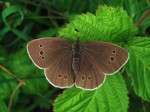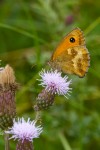Ringlet (Aphantopus hyperantus), Meadow Brown (Maniola jurtina) and Gatekeeper (Pyronia tithonus) may not be our most charismatic butterfly species however, they can be some of our most abundant, so look out for these this summer when you are out and about. The Meadow Brown will even fly in dull weather. Typically, the Ringlet prefers long lush grass in damp conditions away from the full heat of the sun where food plants will be abundant, such areas include hedgerows, field margins and woodland rides. The Meadow Brown also uses such habitats however, it prefers any grassland situation including heavily grazed areas and your back gardens. With the Gatekeeper using grassy areas around scrub and hedgerows. This difference in niche, is most likely as a result of the larval food plants and their nutritional value. The Ringlet preference is coarse grass Cocksfoot (Dactylis glomerata) and False Brome (Brachypodium sylvaticum) Image 1, whereas the Meadow Brown and Gatekeeper go for fine grasses particularly Bents (Agrostis spp.) and Fescues (Festuca spp.).
- Image 2 Ringlet showing the typical underside of the wings © UK Butterflies Peter Eeles
- Image 3 ringlet male showing upperwing surface Copyright UK Butterflies Peter Eeles
- Image 4 Ringlet Female showing upperside of wings © UK Butterflies Vince Massimo
- Image 5 Meadow Brown female showing typical underside of the wings © UK Butterflies Peter Eeles
- Image 6 Meadow Brown male showing typical underside of the wings © UK Butterflies Vince Massimo
- Image 7 Meadow Brown male showing upperside fo wings © UK Butterflies Vince Massimo
- Image 8 Meadow Brown female showing the upperwing surface © Justin Groves The University of Reading
- Image 9 Gatekeeper showing the typical underside to the wings © UK Butterflies Peter Eeles
- Image 10 Gatekeeper male showing the upperside of the wings © UK Butterflies Peter Eeles
- Image 11 Gatekeeper female showing tyical upperside of the wings © UK Butterflies Peter Eeles
The Meadow Brown is found through the UK including the Orkneys, but not the Shetland Isles, with the Ringlet not far behind covering most of the UK up to a line approximately between Inverness and Fort William, using the data base of the National Biodiversity Network (NBN). The Gatekeepers range is also expanding, now reaching as far north as between Carlisle and Newcastle upon Tyne, with only a few records further north. The three species only have only one generation a year, the Ringlet beginning to emerge in mid June and ending by mid August, the Meadow Brown emerging in early June lasting until late September and the Gatekeeper emerging from early July and ending by late August. The species overwinter as larvae, in the case of the Ringlet in the 3rd instar and the Gatekeeper after the 1 instar but in particularly mild winter weather, both the Meadow Brown and Ringlet will feed. The Ringlet larvae being strictly nocturnal, the Meadow Brown only nocturnal as the larvae matures and the Gatekeeper only nocturnal after it emerges in spring. All the species larvae crawl up grass stems to feed.
The Ringlet is the easiest of the three to identify from beneath; all the wings are brown and have a row of black eye spots with a yellow circle surrounding and a white dot at the centre see image 2. From above, males look totally brown with just a few faint small eye spots, females are also totally brown from above, but they have visible eye spots, the same colour as below the wings see image 3-4. The wingspan is approximately 50mm.
The Meadow Brown from below has three bands of creamy brown on the hindwing and on the forewing the colouration is orange with a small black spot near the wing tip in males and a larger spot in females see image 5-6. From above males appear brown very similar to male ringlets, but have a black spot surrounded by an orange circle near the forewing tip. Females are more colourful with the forewing centre being orange, with a larger black spot with a small white dot in the centre see images 7-8. The wingspan is approximately 55mm.
The Gatekeeper from below has bands of browny orange on the hindwing, interspersed with medium brown patches with white dots at the centre see image 9. The forewing underside is light orange, with an obvious large black patch with two white dots inside it. From above males and females look very similar, with both the hindwing and forewing having orange at the centre with a thick brown line around the edge; the wings also have one black eye spot each. The only difference between males and females is that there is brown at the centre of the forewing in males, whereas in females the centre is unbroken orange see image 10-11. The wingspan is approximately 45mm.
Sites you may wish to visit are:
http://www.butterfly-conservation.org/
http://www.ukbutterflies.co.uk/index.php
http://www.hantsmoths.org.uk/index.htm
Please record any sighting seen on campus including the date, in the comments section below, for assessment by subsequent authors.
We thank photographers from UK Butterflies for permission to use their images. Individual credits are given with each image.










